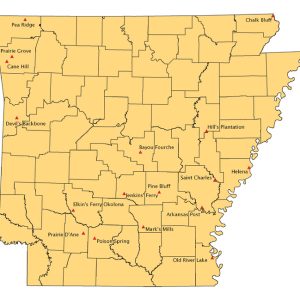calsfoundation@cals.org
Skirmish at Pine Bluff (July 22, 1864)
| Location: | Jefferson County |
| Campaign: | None |
| Date: | July 22, 1864 |
| Principal Commanders: | Major Linn K. Thacher (US); a Captain Lightfoot (CS) |
| Forces Engaged: | Ninth Kansas Cavalry (US); Troops from Brigadier General William Cabell’s Confederate cavalry brigade (CS) |
| Estimated Casualties: | Unknown (US); 1 wounded (CS) |
| Result: | Union victory |
With the return of the Union forces to Little Rock (Pulaski County) after the Camden Expedition, Confederate forces took the initiative in southern Arkansas. While Federal units held Little Rock, Pine Bluff (Jefferson County), and other settlements along the Arkansas, White, and Mississippi rivers, Confederate units operated with ease between these settlements. Confederate forces took advantage of the relative isolation of Federal outposts to operate unchecked in the countryside between occupied cities. Union commanders responded by sending out patrols to disrupt Confederate organizational efforts.
The Ninth Kansas Cavalry served in the District of the Frontier until July 2, 1864, when the unit received orders transferring it to Little Rock. The Kansans did not make a positive impression on their new comrades, with Colonel Abraham Ryan of the Third Arkansas Cavalry (Union) reporting that members of the unit robbed friend and foe alike.
Moving to Little Rock, the Ninth Kansas began to conduct regular patrols to the south. At the same time, Brigadier General William Cabell’s Confederate cavalry brigade spread across southern Arkansas in an effort to resupply and recruit new members while recovering from hard service during the Camden Expedition.
On July 22, Major Linn Thacher of the Ninth Kansas led a scouting party near Pine Bluff. About fifteen miles northwest of the city, the Federals encountered a Confederate camp that was part of Cabell’s brigade. Under the command of a Captain Lightfoot, the Confederates were surprised by the Union troops. Unable to fight back, the Confederates fled in confusion; one man was wounded. Additionally, two horses, three guns, and a large of amount of provisions and medical supplies were captured.
After destroying the provisions and medical supplies, Thacher and his men returned to Little Rock. Although it was only a brief action with minimal losses on either side, this type of engagement became common in the state as small units operated in the void left by the inaction of large armies.
For additional information:
The War of the Rebellion: A Compilation of the Official Records of the Union and Confederate Armies. Series 1, Vol. 41, Pt. 1. Washington DC: Government Printing Office, 1889.
David Sesser
Henderson State University
 ACWSC Logo
ACWSC Logo  Civil War Events Map
Civil War Events Map 




Comments
No comments on this entry yet.